Kerala Plus One Botany Notes Chapter 7 Transport in Plants
Translocation:
It is the transport over longer distances takes place through the vascular system (the xylem and the phloem)
Means of transport:
Diffusion:
- It is passive process takes place from the regions of higher concentration to regions of lower
- Diffusion is a slow process and is not dependent on a ‘living system’, it mainly occurs in gases and liquids.
- Diffusion is very important to plants for gaseous movement within the plant body.
Rate of diffusion:
Factors influencing diffusion are
- Gradient of concentration
- The permeability of the membrane separating them
- Temperature and pressure.
Facilitated Diffusion:
Substances that have a hydrophilic moiety difficult to pass through the membrane, their movement to be facilitated by protein.
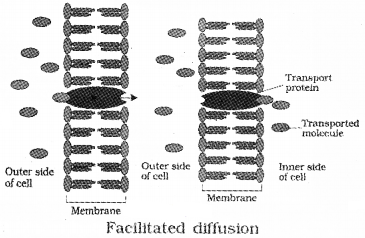
What is the requirement for facilitated diffusion?
- Special membrane proteins help the movement of substances across membranes
- Movement of substance takes place without the expenditure of ATP or energy.
Rate of facilitated diffusion:
The diffusion rate depends on the
- size of the substances.
- solubility in lipids
Features:
- Substances soluble in lipids diffuse through the membrane faster.
- It is specific and allows the cell to select substances for uptake.
- It is sensitive to inhibitors which react with protein side chains.
- Transport rate reaches a maximum when all of the protein transporters are being used (saturation).
- The proteins form channels in the membrane. Some channels are always open others can be controlled
Nature of transport protein:
1. The porins are proteins that form huge pores in the outer membranes of the plastids, mitochondria and some bacteria that allowing molecules up to the size of small proteins to pass through.
2. Some of the transport protein rotates and releases the molecule inside the cell, eg: water channels – made up of eight different types of aquaporins.

Passive symports, antiports and uniport:
- In a symport, both molecules cross the membrane in the same direction with help of carrier or transport proteins.
- In an antiport, they move in opposite directions.
- When a molecule moves across a membrane independent of other molecules, the process is called uniport.
Active Transport:
Active transport is a uphill process why?
- Proteins transport substances from a low concentration to a high concentration (‘uphill’ transport) by using energy
- It is carried out by membrane-proteins.
- Transport rate reaches a maximum when all the protein transporters are being used or are saturated.
- This carrier protein is very specific in transport and sensitive to inhibitors that react with protein side chains.
Comparison of Different Transport Processes:
- Proteins in the membrane show common characteristics of being highly selective; they are liable to saturate, respond to inhibitors and are under hormonal regulation.
- But diffusion whether facilitated or not take place only along a gradient and do not use energy.

Plant- Water relations:
- Water is the medium in which most substances are dissolved.
- The protoplasm of the cell contains water in which different molecules are dissolved and suspended.
- A watermelon has over 92 percent water; most herbaceous plants have only about 10 to 15 percent of its fresh weight as dry matter.
- Terrestrial plants take up huge amount water daily but most of it is lost to the air through evaporation from the leaves, i.e., transpiration.
- A mature corn plant absorbs almost three litres of water in a day, while a mustard plant absorbs water equal to its own weight in about 5 hours.
- Water is the limiting factor for plant growth and productivity.
Water Potential:
- It is the sum of Solute potential and pressure potential.
- Ψw=Ψx+Ψp
- Water potential is denoted by the Greek symbol Psi.
- It is expressed in pressure units such as pascals (Pa).
Solution have a lower water potential than pure water why?
When solute dissolves water potential is decreased called solute potential (negative sign)
- Water molecules possess kinetic energy. The greater the concentration of water in a system, the greater is its kinetic energy or ‘water potential’.
- Water move from the higher water potential to the lower water potential.
How can increase water potential?
- If a pressure greater than atmospheric pressure is applied to pure water or a solution, its water potential increases
- Water enters a plant cell due to diffusion causing a pressure built up against the cell wall, it makes the cell turgid, this increases the pressure potential. (sign is positive)
- Water potential of a cell is affected by both solute and pressure potential.
| For a solution at atmospheric pressure (water potential) = (solute potential) |
| Pure water have the greatest water potential. It is taken as zero. |
Osmosis:
It is the diffusion of water across the semi-permeable membrane.
Rate of osmosis: It is influenced by
- pressure gradient
- concentration gradient.
1. In plant cells, the cell membrane the membrane of the vacuole (tonoplast) are together determines the movement of molecules in or out of the cell.
2. Water flows from its region of higher chemical potential (or concentration) to its region of lower chemical potential until equilibrium is reached.
3. At equilibrium the two chambers should have the same water potential.
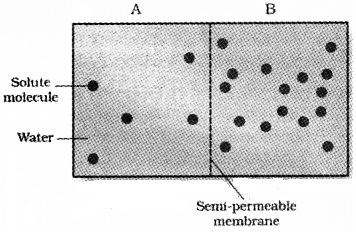
Experiment to demonstrate osmosis:
1. In potato osmometer experiment, the tuber is placed in water the cavity in the potato tuber containing a concentrated solution of sugar collects water due to osmosis.
2. In thistle funnel experiment, sucrose solution in a funnel is separated from pure water in a beaker through a semi-permeable membrane .After some time water will move into the funnel resulting in rise in the level of the solution in the funnel. This will continue till the equilibrium is reached.
Reverse osmosis:
If an external pressure is applied from the upper part of the funnel, no water diffuses into the funnel through the membrane.
1. This pressure required to prevent water from diffusing is the osmotic pressure and this is the function of the solute concentration.
2. If increasing the solute concentration, the greater pressure is required to prevent water from diffusing in. Osmotic pressure is the positive pressure applied, while osmotic potential is negative.
3. A demonstration of osmosis. A thistle funnel is filled with sucrose solution and kept inverted in a beaker containing water, (a) Water will diffuse across the membrane (as shown by arrows) to raise the level of the solution in the funnel (b) Pressure can be applied as shown to stop the water movement into the funnel.
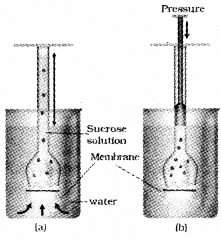
Plasmolysis:
Importance of hypertonic solution:
When a cell is placed in a hypertonic solution water moves out due exosmosis, it causes the protoplast to shrink away from the walls. This is called plasmolysis. The cell become flaccid in state. The process of plamolysis is usually reversible.
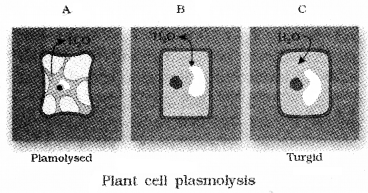
Cells become turgid state in pure water?
When the cells are placed in a hypotonic solution (higher water potential or dilute solution as compared to the cytoplasm), water diffuses into the cell due to endosmosis causing the cytoplasm to build up a pressure against the wall, that is called turgor pressure.
Isotonic solution:
If the external solution balances the osmotic pressure of the cytoplasm,it is said to be isotonic. When the cell (or tissue) is placed in an isotonic solution, there is no net flow of water towards the inside or outside. If the external solution is more dilute than the cytoplasm, it is hypotonic, cells swell in hypotonic solutions and shrink in hypertonic ones.
Imbibition:
Imbibition is a special type of diffusion when water is absorbed by hydrophilic colloids and increase in volume.
Examples of imbibition:
- Absorption of water by seeds and dry wood
- Emerging out of seedlings from the soil
Water potential gradient between the absorbent and the liquid imbibed is essential for imbibition.
Long distance transport of water:
- Mass flow is the movement of substances in bulk or en masse from one point to another as a result of pressure differences between the two points.
- The bulk movement of substances through the conducting or vascular tissues of plants is called translocation.
- Xylem is associated with translocation of water, mineral salts, some organic nitrogen and hormones, from roots to the aerial parts of the plants.
- Phloem translocates organic and inorganic solutes, mainly from the leaves to other parts of the plants.
How do Plants Absorb Water?
Water is absorbed along with mineral solutes move deeper into root layers by two distinct pathways.
1. Apoplast pathway:
- The apoplastic movement of water occurs exclusively through the intercellular spaces and the walls of the cells except at the casparian strips of the endodermis in the roots.
- The apoplast does not provide any barrier to water movement and water movement is through mass flow i.e tension develop in the continuous stream of water in the apoplast due to the adhesive and cohesive properties of water

2. Symplast pathway:
- In symplastic movement the water travels through the cytoplasm of the cells
- This intercellular movement takes place through the plasmodesmata. ‘Symplastic movement is aided by cytoplasmic streaming.
- eg: cytoplasmic streaming in cells of the Hydrilla leaf; the movement of chloroplast due to streaming is easily visible.
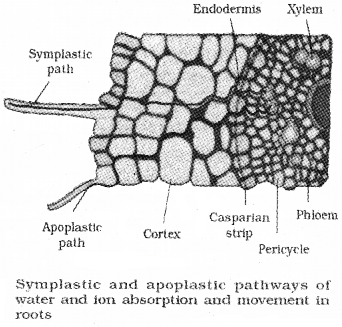
Apoplastic pathway is not always continuous through cell wall why?
Apoplastic pathway is continuous upto the inner boundary of the cortex, the endodermis, is impervious,to water because of a band of suberised matrix called the casparian strip.
The water then moves through the symplast and again crosses a membrane to reach the cells of the xylem. This is the only way water and other solutes can enter the vascular cylinder.
Additional structures in water and mineral absorption:
1. A mycorrhiza is a symbiotic association of a fungus with a root system. The hyphae have a very large surface area that absorb mineral ions and water from the soil. The fungus provides minerals and water to the roots, in turn the roots provide sugars and N-containing compounds to the mycorrhizae.
2. Some plants have an obligate association with the mycorrhizae. For example, Pinus seeds cannot germinate and establish without the presence of mycorrhizae.
Water Movement up a Plant:
Root Pressure:
- As various ions from the soil are actively transported into the vascular tissues of the roots, water flows (its potential gradient) and increases the pressure inside the xylem.
- This positive pressure is called root pressure.
- It helps to pushing up water to small heights.
Experiment to demonstrate root pressure:
When a small soft-stemmed plant is taken and cut the stem horizontally near the base with a sharp blade, early in the morning ,the drops of solution ooze out of the cut stem; this occurs due to positive root pressure.
When root pressure is high in herbaceous plants?
Effects of root pressure is also observable at night and early morning when evaporation is low, and excess water collects in the form of droplets around special openings of veins near the tip of grass blades, and leaves of many herbaceous parts.
Such water loss in its liquid phase is known as guttation. Root pressure do not play a major role in water movement up tall trees but it occurs in most plants by transpiratory pull
Transpiration pull:
- Water is mainly ‘pulled’ through the plant with help of driving force – transpiration from the leaves referred to as the cohesion – tension – transpiration pull model of water transport.
- Less than 1 percent of the water reaching the leaves is used in photosynthesis and plant growth.
- Most of it is lost through the stomata in the leaves. This water loss is known as transpiration.
Transpiration:
Transpiration is the evaporative loss of water occurs mainly through the stomata in the leaves.
- Normally stomata are open in the day time and close during the night.
- The opening or closing of the stomata is due to change in the turgidity of the guard cells.
- The inner wall of each guard cell is thick and elastic.
- When turgidity increases within the two guard cells the thin outer walls bulge out and opens the stoma. This is also aided due to the orientation of the microfibrils in the cell walls of the guard cells.
- When the guard cells lose turgor, due to water loss (or water stress) the guard cells become flaccid and the stoma closes.
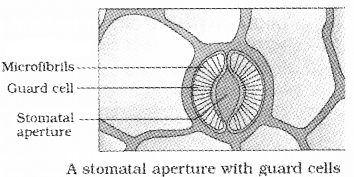
Distribution of stomata in leaf:
- The dorsiventral (often dicotyledonous) leaf has a greater number of stomata in the lower surface
- Isobilateral (often monocotyledonous) leaf they are equally distributed on both surfaces.
Factors influencing transpiration:
External factors:
Temperature, light, humidity, wind speed
Plant factors:
Number and distribution of stomata, number of stomata open, per cent, water status of the plant, canopy structure, etc.
The transpiration driven ascent of xylem sap depends mainly on the following physical properties of water:
| 1. Cohesion: mutual attraction between water molecules. 2. Adhesion: attraction of water molecules to polar surfaces (such as the surface of tracheary elements). 3. Surface Tension: water molecules are attracted to each other in the liquid phase more than to water in the gas phase. |
- These properties give water high tensile strength, i.e., an ability to resist a pulling force, and high capillarity, i.e., the ability to rise in thin tubes.
- In plants capillarity is aided by the small diameter of the tracheary elements – the tracheids and vessel elements
- As water evaporates through the stomata results in pulling of water molecule by molecule, into the leaf from the xylem.
- This occurs due to lower concentration of water vapour in the atmosphere as compared to the substomatal cavity and intercellular spaces, water diffuses into the surrounding air. This creates a ‘puli’.
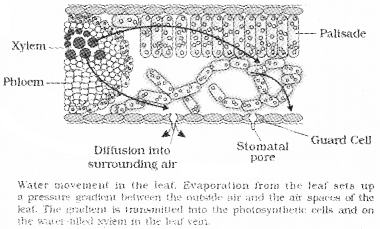
Transpiration and Photosynthesis – a Compromise:
Advantageous of transpiration:
- creates transpiration pull for absorption and transport of plants
- supplies water for photosynthesis
- transports minerals from the soil to all parts of the plant
- cools leaf surfaces, sometimes 10 to 15 degrees, by evaporative cooling
- maintains the shape and structure of the plants by keeping cells turgid
- When water depleted by transpiration, photosynthesis is limited.
- The evolution of the C4 photosynthetic system maximising the availability of CO2 while minimising water loss.
- C4 plants are twice as efficient as C3 plants in terms of fixing carbon (making sugar). C4 plant loses only half as much water as a C3 plant for the same amount of CO2 fixed.
Uptake and transport of mineral nutrients: The nutritional requirements are obtained from minerals in the soil.
Uptake of Mineral Ions:
All minerals cannot be passively absorbed by the roots because
| (i) minerals are present in the soil as charged particles (ions) which cannot move across cell membranes. (ii) the concentration of minerals in the soil is usually lower than the concentration of minerals in the root. Therefore, most minerals must enter the root by active absorption. This needs energy in the form of ATP |
- The active uptake of ions is partly responsible for the water potential gradient in roots, and therefore for the uptake of water by osmosis.
- Specific proteins in the membranes of root hair cells actively pump ions from the soil into the cytoplasm of the epidermal cells.
- Root endodermis because of the layer of suberin has the ability to actively transport ions in one direction only.
Translocation of Mineral Ions:
Chiefsinks:
- Apical and lateral meristems
- young leaves
- developing flowers
- fruits and seeds
- the storage organs
Unloading of mineral ions occurs at the fine vein endings through diffusion and active uptake by these cells.
| Mineral ions are frequently remobilized from older senescing parts to younger leaves. Some decidous plants, before leaf fall minerals are removed to other parts Mobilising elements are phosphorus, sulphur, nitrogen and potassium. |
- Some elements that are structural components like calcium are not remobilised.
- An analysis of the xylem exudates shows that though more amount of nitrogen carried in the organic form as amino acids small amounts of P and S are carried as organic compounds.
- Small amount of exchange of materials does take place between xylem and phloem.
Phloem transport: flow from source to sink:
Phloem transport is bidirectional but xylom transport is unidirectional why?
Source is the part of the plant which synthesises the food. Sink is the part that needs or stores the food. Food ( sucrose) is transported by phloem from a source to a sink.lt is the downward transport Sugar stored in roots are mobilized to the buds of trees during early spring and act as sink.
This is called upward transport .Hence phloem transport is bi-directional. Phloem sap is mainly water and sucrose, but other sugars, hormones and amino acids are also transported or translocated through phloem. Xylem transport is always unidirectional, i.e. upwards.
The Pressure Flow or Mass Flow Hypothesis:
The accepted mechanism used for the translocation of sugars from source to sink is called the pressure flow hypothesis.
What is the loading of phloem?
The sugar is moved in the form of sucrose(a disaccharide) into the companion cells and then Tlpo!stem. into the living phloem sieve tube cells by active transport. This process is called loading. It produces a hypertonic condition in the phloem.
- Phloem tissue is composed of sieve tube cells, which form long columns with holes in their end walls called sieve plates. ‘Cytoplasmic strands pass through the holes in the sieve plates,
- Water in the adjacent xylem moves into the phloem by osmosis.
- As hydrostatic pressure( Osmotic pressure) builds up in the in the phloem sieve tube, pressure flow begins and phloem sap move to areas of lower pressure
- Active transport is necessary to move the sucrose out of the phloem sap and sugars are removed, the osmotic pressure decreases and water moves out of the phloem.
- The loss of solute produces a high water potential in the phloem, and water passes out to xylem.
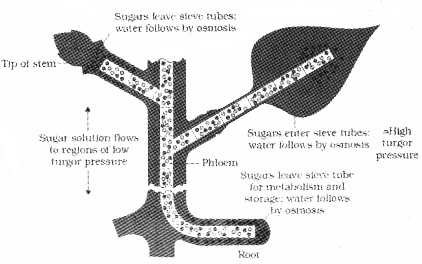
Girdling experiment:
It is used to identify the tissues through which food is transported. On the trunk of a tree, a ring of bark up to the depth of the phloem layer is removed. In the absence of downward movement of food, the portion of the bark above the ring on the stem becomes swollen after a few weeks.
This simple experiment shows that phloem is the tissue responsible for translocation of food and transport takes place in one direction, i.e., towards the roots.
